In Pursuit of Paris: the Stories of the VAA Residence Cité Internationale des Arts. Part III
Jurga Barilaitė
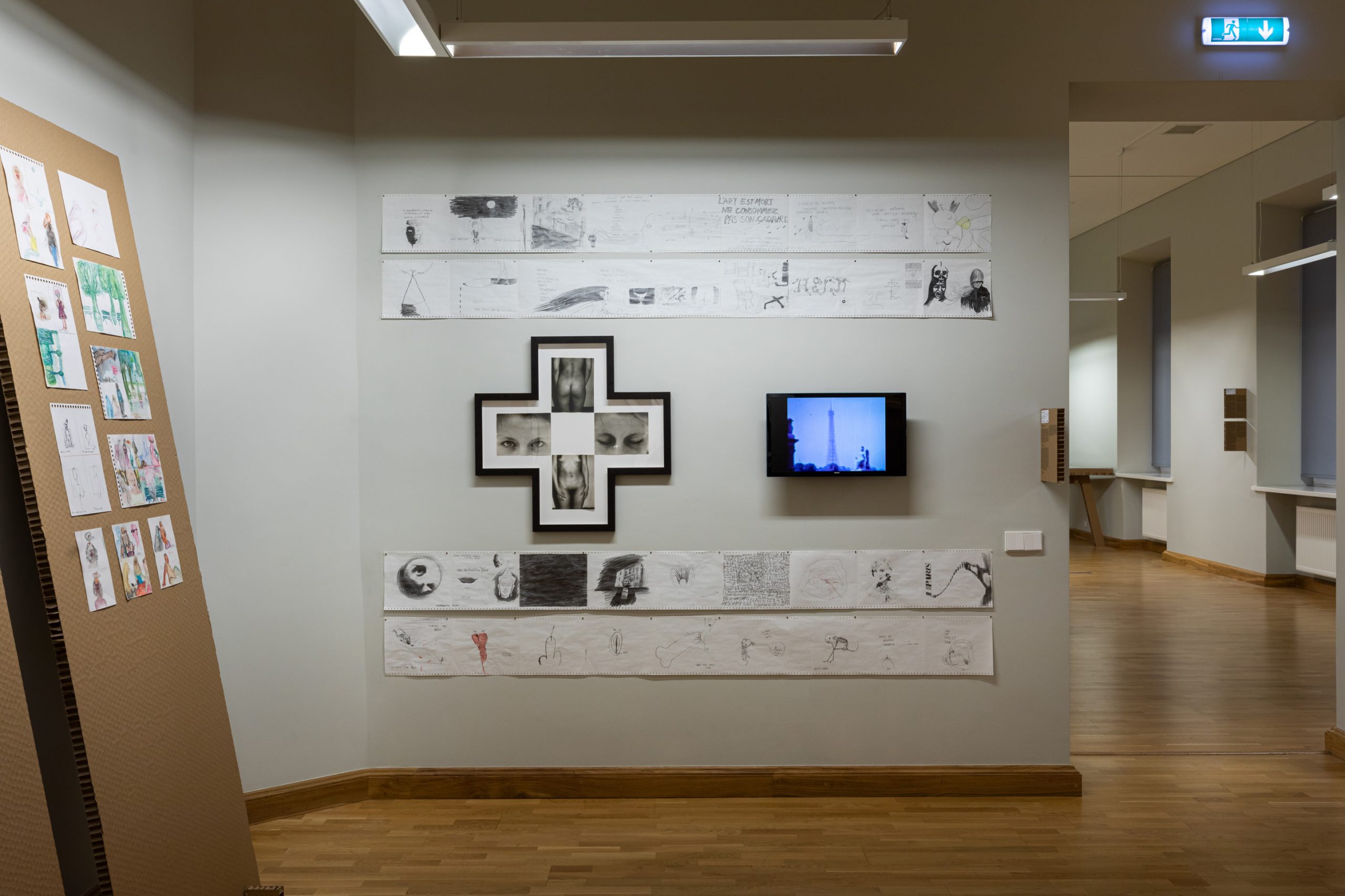
Te greed (inaccessible desires, a voyeuristic glance, and unconscious resistance to the system)
Death and girl
A series of drawings, 1995–2020
A horror novella, based on some personal adventures, dreams and drawings experienced and imagined in Paris in 1995. It is about an innocently inculpated girl who dies every evening, rises from the dead every night and ambles in the nocturnal city. Only notes and several drawings survived from the 1995 psychogeographic drifting through the city. The rest are from 2019. I was drawing in an attempt to remember, but these are already the memories evoked at present time. Based on my notes, I saw an exhibition of Asger Oluf Jorn. I can recall nothing except some kind of delineations. It turns out that at the time I was already familiar with the ideas of Lettrism and Situationism.
Paris’66
Video, 20’
A digitized 8 mm travel film from 1966 by an unknown cameraman (at least it is the date indicated on several tapes bought by a friend of mine several years ago at a flea market in Vilnius). It is a footage of Paris observed greedily by unaccustomed eyes of a person from the Soviet world: city adds, beautifully dressed women, shop counters with abundant goods, fruit, bananas, pages of erotic magazines and film posters. As we know, at the time, very few people from the Soviet Union could travel to Paris, only the ideologically reliable ones. These are the so called times of Khrushchev Thaw. The footage has no commentary. The pictures have been preserved; the camera follows the shooting person’s glance. At the time, protests against merchandise fetishism were already brewing in Paris, as well as demands to ‘interdit d’interdire’. The time is several years before the 1968 events. The New Wave films are being made, the Situationalists engage in the practice of the derive (‘drifting’), and in 1967 Guy Debord publishes his The Society of the Spectacle.
In 2020, I added title animation.
I stayed in Paris at the Cité Internationale des Arts in August and September 1995. The ‘museum –visiting scholarship’ was the VAA Student Art Days prize. I was in my fifth year of the painting study programme. I won the 1st prize for the installation Mimicry and a two-months stay at the Cité Internationale des Arts. Darius Žiūra and Dainius Liškevičius each won a month-long residence in Paris. We shared the residence and the studio with Žiūra in August, and spent September together with Liškevičius.
Julius Keleras

Paris: real/ideal/imaginary
There are cities that zoom like a highway to nowhere – like New York City or Tokyo. They seem oblivious to the fact that human life and the world are not dominated by speed alone. True, it is a subjective perception. It is obvious: all perceptions are anchored in personal experience, the power of imagination and understanding.
Paris is subjective as well. It’s like an inclusion between me and you, between him/her and the other. We try to figure out who we are until one day we get to Paris. When there, we get to see ourselves for the first time again, and we are seen by the city. When submerging us in itself, it does not submerge us into reflections in the Seine; neither does it open a latch of the imaginary gate in the Bastille’s prison; the city leaves it locked, attempting to tangle us up in history and make us stay in its webs, but not like prisoners. Like passers-by, observers, figures resting on the lawn at the Jardin de Luxembourg. The city does not invite us in, we do not become insiders.
I happened to arrive in Paris in October of 2009. When I reached the door of the Lithuanian studio, I had already forgotten the smells of the metro and the turns of its underground passages. I took a peek through the window: baguettes were not ready yet. In the evening, the temporary settlers of the Cité in their tiny studios were preoccupied with something else. I entered the area of the Arts campus and nearly tripped over homeless people, lying on the ground. They were sprawled like barricades around the protected façade. The homeless were easy to avoid – all it took was just to leave them alone and not to engage in conversation. Some were barbecuing sausages, napping in the tents, yet others with headsets on their heads listened to something (I guess Mahler No 6 or Edith Piaf). Paris here did not smell of sponge-cake or of marzipan brioche.
The imperial spirit of the town cast a spell on me – the scenery, the gait, the boulevard turns, the parks. It struck me as a feminine space where emperors from its early days projected their fate into the feminine niches of their masculine museums. This city does not remind me of an adolescent who reads all night, unable to cope with his pubescent body, his ennui, his unreachable and unconquerable future. This city is tough – it is walking, climbing, descending the stairs, floating on barges. It is friendly to itself, loyal to itself; its heart is somewhere at the bottom of the Seine, but it is charming, completely. It loves only itself – a perfect realization of a platonic ideal.
The Lithuanian VAA studio is located in this unusual building, not far from the Pont des Arts which functions like a character in a Julio Cortázar novel. The Cité des Arts brings together multiple nations and cultures. It is a place of drawing, painting, music creation, and surely, wine drinking. Valdas Papievis, a local advocate of Bacchus, will give you genius advice on what and how to buy (‘Never pay for wine in Paris over a couple of euros. It is sure to be of a lesser quality.’)
Wine, arts, street markers, parks and boulevards are enjoyable not only for artists, yet for an artist they are especially important. These are my memories of Paris – the city that also has a trace of Vytautas Kasiulis, Antanas Mončys, Leonas Kiauleikis and many other compatriots.
Konstantinas Bogdanas
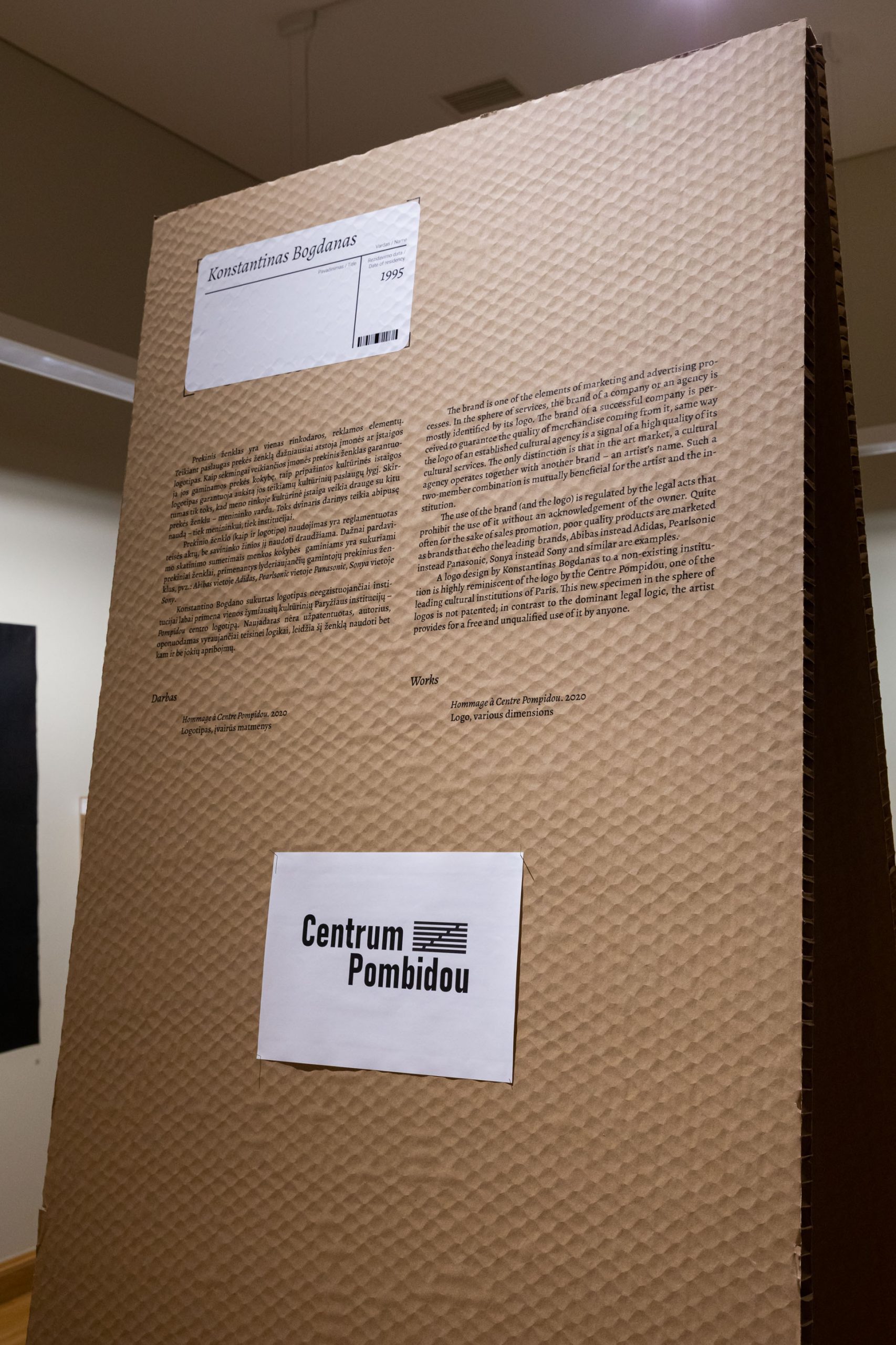
The brand is one of the elements of marketing and advertising processes. In the sphere of services, the brand of a company or an agency is mostly identified by its logo. The brand of a successful company is perceived to guarantee the quality of merchandise coming from it, same way the logo of an established cultural agency is a signal of a high quality of its cultural services. The only distinction is that in the art market, a cultural agency operates together with another brand – an artist’s name. Such a two-member combination is mutually beneficial for the artist and the institution.
The use of the brand (and the logo) is regulated by the legal acts that prohibit the use of it without an acknowledgement of the owner. Quite often for the sake of sales promotion, poor quality products are marketed as brands that echo the leading brands, Abibas instead Adidas, Pearlsonic instead Panasonic, Sonya instead Sony and similar are examples.
A logo design by Konstantinas Bogdanas to a non-existing institution is highly reminiscent of the logo by the Centre Pompidou, one of the leading cultural institutions of Paris. This new specimen in the sphere of logos is not patented; in contrast to the dominant legal logic, the artist provides for a free and unqualified use of it by anyone.
Laima Drazdauskaitė
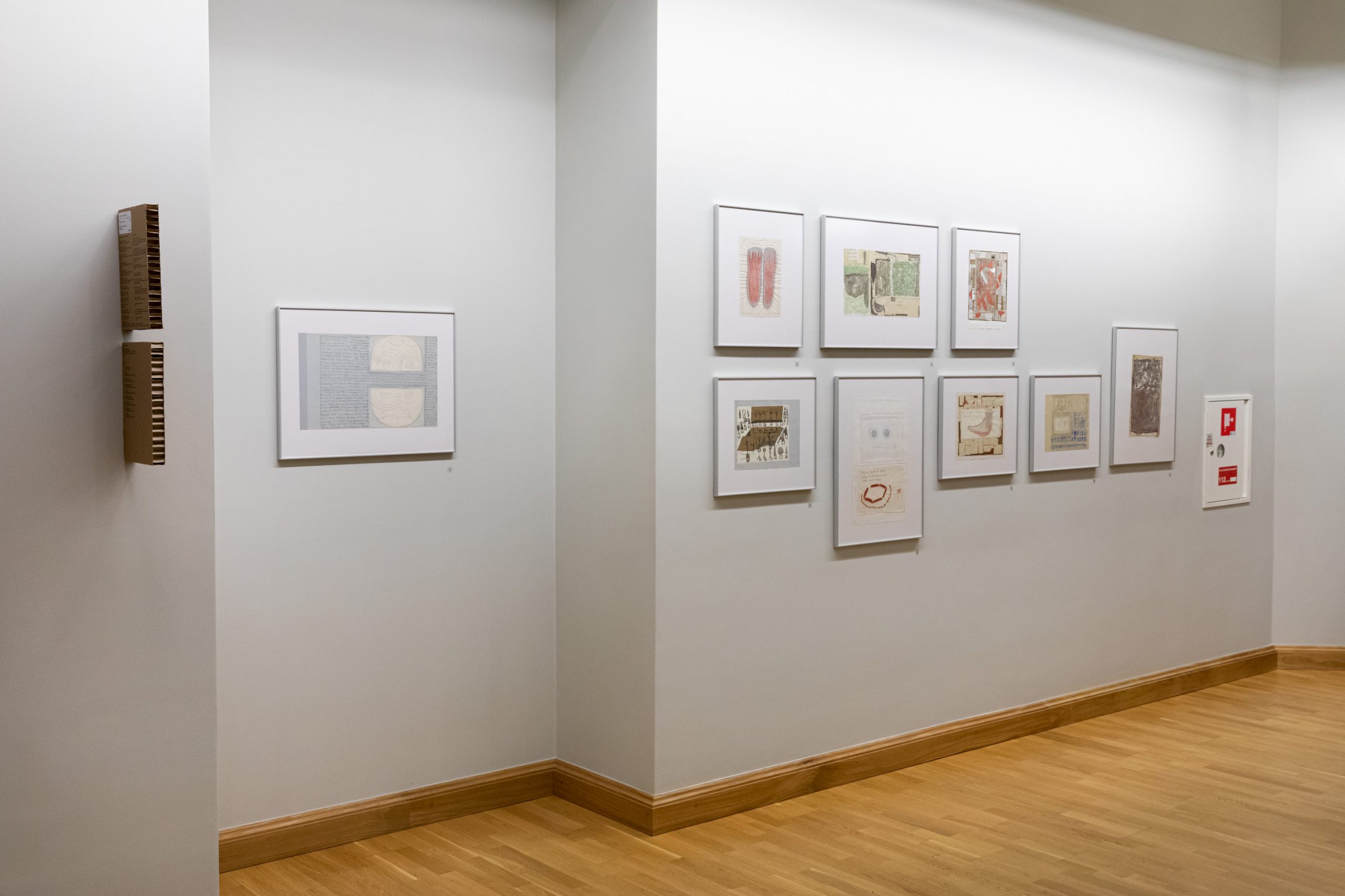
My Paris Marathon. A page from ‘Parisian album’
Cité Internationale des Arts, Paris, 1998
Thursday, September 3
Charles de Gaulle, Opera, Cité Internationale des Arts.
Friday, September 4
My first day in Paris. Light drizzle. Notre Dame, Île Saint-Louis, Île de la Cité. Valdas Papievis.
Saturday, September 5
Sainte-Chapelle, Tour Saint-Jacques, Hôtel de Ville, Église Saint-Gervais.
Sunday, September 6
Notre Dame, Centre Pompidou, Marché Bastille, Le Marais.
Monday, September 7
Musée de Cluny, Sorbonne Université, Montagne Sainte-Geneviève, Panthéon, Saint-Étienne-du-Mont.
Tuesday, September 8
Envelopes, post stamps, calling card, code, Musée d’Orsay, St. Denis, Château de Vincennes, La Défense.
Wednesday, September 9
Musée d’Orsay, Académie des Beaux-Arts.
Thursday, September 10
Marché Bastille, Musée de Cluny.
Friday, September 11
Louvre, Babylon, French painting.
Saturday, September 12
Louvre, the Dutch.
Sunday, September 13
Light drizzle, Marché Bastille, Louvre bookstore.
Monday, September 14
Picasso , Brâncuși, Dalí, Montmartre.
Tuesday, September 15
Musée d’Art Moderne de la Ville de Paris, Place de l’Alma, Rue Saint-Honoré, Place Vendôme, Saint-Eustache, Notre Dame, Sainte-Chapelle.
Wednesday, September 16
Jeu de Paume, P. Alechinsky, Petit Palais, Italians, Dutch, German, French, Les Invalides, Army Museum, Napoleon’s grave, Rodin.
Thursday, September 17
Musée International d’Art Naïf, Art Outsider et Folk Art des Collections de Chicago, Polish Library, A. Mickevičius’ Museum, Chopin, Saint-Séverin, mosque, amphitheatre.
Friday, September 18
Versailles, park.
Saturday, September 19
Musée de l’Orangerie, Van Gogh, F. Millet, Delacroix, Holy Mass at the Notre Dame.
Sunday, September 20
Jardin des Plantes à Saint-Louis.
Monday, September 21
Père Lachaise, Maillol Museum, Frida Kahlo, contemporary Japanese art.
Tuesday, September 22
Claude Monet, Berthe Morisot, miniatures, A. Mickevičius’ monument, Musée d’Orsay, Van Gogh-Millet, Impressionists, Post-Impressionists, Mr Žibuntas Mikšys.
Wednesday, September 23
Musée d’Orsay, a boat trip down the Seine, Quartier Latin.
Thursday, September 24
Chartres.
Friday, September 25
Chinese vases, Musée Guimet, Proust’s favourite park, sightseeing bus trip of Paris.
Saturday, September 26
Louvre.
Sunday, September 27
Mass at the Notre Dame, Marché Bastille, rain, a walk down the Seine.
Monday, September 28
Arranged a meeting with Mr B at 30/09/5 pm/ Musée de Cluny, a promenade; Jardin du Luxembourg, observatory…
Orūnė Morkūnaitė
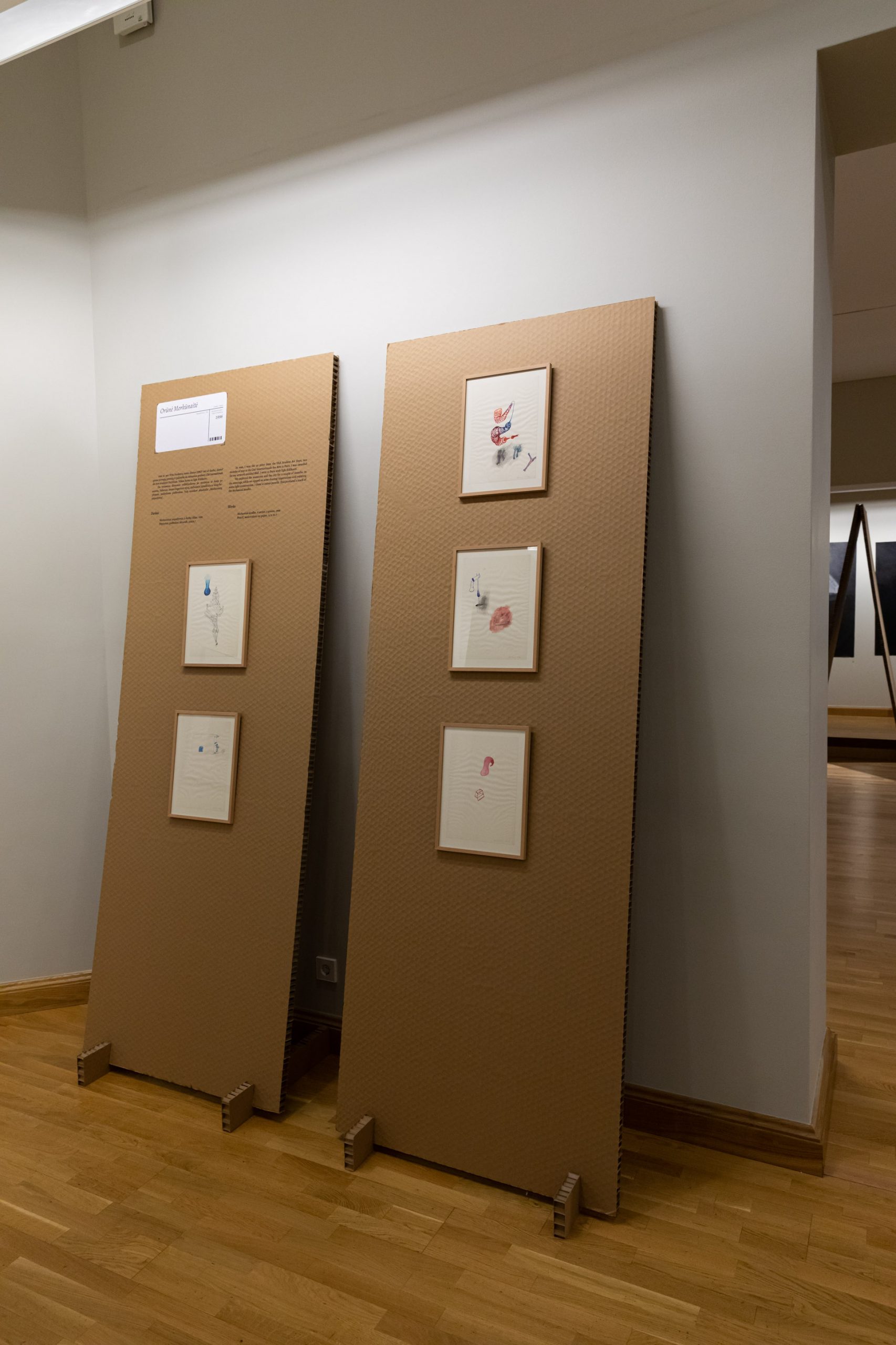
In 1996, I won the 1st prize from the VAA Student Art Days, two months of stay at the Cité Internationale des Arts in Paris. I was awarded for my artwork entitled Wall. I went to Paris with Eglė Ridikaitė.
We explored the museums and the city for a couple of months. In the evenings, while we sipped on wine sharing impressions and enjoying some light conversation, I drew in colour pencils. This produced a stack of Mechanical doodles.
Ramutė Rachlevičiūtė
Paris, my Paris…
Paris has early engrained into my art historian’s consciousness as a place indispensable to experience first-hand for the understanding of modern art. For decades, the history of modernism evolved as art produced by French, or by artists from other countries, in Paris. This Francophone concept of modernism was subjected to revision by different Western European countries during the last two decades of the 20th century in order to introduce multiple variants of ‘modernism’, and all other ‘isms’ highlighting Italian, German, Russian, Eastern, Central European, Latin American, and even Asian-Indian contribution to the story of Western modernism.
Cilė Žiburkienė, the general’s spouse and intellectual, recalls her interwar period travel to Paris. They designed their concrete plans for each particular visit, leaving other things for subsequent ones. ‘We knew we were to return to that magic place and had no goal to grasp it all at once.’ The artist Irena Trečiokaitė-Žebenkienė arrived in Paris in 1937 with two goals: to visit Paris World’s Fair and to get married by a civil ceremony, something unavailable in Lithuania at the time.
As a student of the history of art, I always longed to go to Moscow, Leningrad, Minsk or Kiev to see art exhibitions especially those brought over from ‘the rotten West’, as Western Europe and the USA were referred to over soviet period. Paris was beyond my reach at the time. In theory, members of art community could travel there with a group from the Culture Ministry with a blessing from the Artist’s Union. Yet I was not ‘of the level’ and not appropriately connected in order to be included into trips to Western Europe for culture professionals, organized from either Vilnius or Moscow.
There was also another, less prestigious avenue to get to travel to the West. It was through ‘a backing’ not at the Ministry of Culture or the Artists’ Union, but at the socalled Trade Union Board who distributed state arranged and paid trips for collective-farmers and workers. Mostly these trips were desired as shopping opportunities and the countries preferred were those offering gold items and jewellery, and jeans. They offered poorer cultural opportunities, yet not entirely none. I had ‘a backing’ with this board and bribed an individual on it (these days is a well-established prospering businessman). My Dad was an industrial engineer who designed storages for factories and plants; through his friends, he provided me with some of fine whiskey. When I went to see the influential trade-union man and, trembling with fear, produced my single bottle, he appraised it with a question whether I would like ‘to visit Vietnam’. In three years, I took two bottles of whiskey and gained his observation that ‘it is time to see India… a gorgeous country’.
With the opening of the boarders after the reestablishment of independence, we went on the first trips to the ‘rotten’ West on a sleeping bus, a relic and rarity (inconceivable today) possession by Šiauliai town. It was a veritable miracle: during the day we drove and stopped and took a short scouting trip to a museum, and covered more distance at night, sleeping like in a dorm bunk… At that time it was perceived as a comfortable and safe travel, and a cool way to economise on time and boarding money!
In the early independence days, I collaborated with the Vilnius Excursion Office. The service of pooling a full bus of passengers and acting as a travel leader – not a guide, but organizer and escort – paid your own travel! I arranged such a journey for art researchers to France. It took not only to organize a full bus of artists and art professionals, but also to absorb complains and to settle squabbles of two colleagues (for instance, over a sun hat and its brim taking too much space on an overhead rack). The organizational fuss on these ‘free’ trips was so draining, that myself I could not remember much… just some things. During that same trip, we stopped in Paris for a couple of days, yet it was very much a crazed rush.
No wonder then that my first opportunity of a ‘free individual’s’-month-stay at the studio of Vilnius Art Academy in the Cité Internationale des Arts was simply a bliss! The first time, surely, was not without great apprehensions about such tasks as how to enter the gate, where to collect my key, to unlock the door, to use a public telephone, to organize my monthly expenses… Being on economy, I had to find the cheapest stores and outdoor markets.
I set for myself an ambitious agenda: to ‘take’ a new museum every day. I simply decided to visit all of the museums in Paris. I started with the ones of the artists who never let me down, except for the Delacroix Museum. A disappointment was not the artist, but the museum collection, as it did not include any significant piece and showed dubious sketches. Otherwise, I liked all the museums, even the Musée de la Chasse et de la Nature where I saw interesting pictures on the animal theme, scenes of the French royalty daily and festive life, and dogs’ costumes created by celebrated designers… At the time due to the limited access of the Internet, it was an exotic and enlightening experience. I visited doll museums and other places, the inconspicuous private collections and important art foundations, all the galleries, private and run by foreign embassies, smaller and larger museums on the outskirts of Paris. A visit to the Japanese Cultural Centre was overwhelming and provided a multifaceted understanding of Japanese culture. My day usually started with the museum opening hours, where I spent a day, while my evenings were dedicated to the library of the Centre Pompidou open until 10 p.m. From its free access shelves, I would drag loads of magazines and books to look through them on the reading room tables. I crawled home entirely spent at 10.30 p.m. and prepared a quick hot meal for myself. I could not afford eating out, therefore I carried my sandwiches with me, yet some museums would not have a place to eat them, so I did that only after leaving the museum.
I was least interested in the activities at the Cité residence and did not attend a single opening of foreign artists’ exhibitions nor make any friends, as it was not in my plans. As the month was ending, I noticed the first symptoms of intoxication and oversaturation with arts, so I delved into the Carrousel du Louvre shops leading to the Louvre, and started looking for Nature and Decouvertes. There I spent an hour among bamboos on display, listening to the trickling of the little fountains, fingering some kind of pebbles and dreaming about a real nature’s bosom in Juodkrantė or somewhere on the River Šventoji.
I remember at the end of the month in Paris being able to appraise the scale of a museum when approaching it, and decide, with a sigh, whether I would manage to see it in a day. I bitterly failed with the Musée des Arts et Métiers, thinking of passing by some of the rooms to stop just where I find it interesting. Yet the size and depth of the museum that introduces not only scientific discoveries, instruments and technologies (e.g., glass manufacturing or the discovery of photography) brought me to the brink of tears when I discovered the rooms with trains of carriages, dedicated to the history of the railroad. They took immense effort to cover, let alone to see all that. Foucault pendulum, therefore, is just a grain in the vast desert of technical discoveries.
I even managed to save some money and took a two-day trip to London where I wanted to see some of exhibitions, and especially the then recently opened Tate Modern and the legendary private Saatchi Gallery of contemporary art. I learned about it in Paris, and in Lithuania, nobody yet talked about it. I wanted to see the ‘real contemporary art’ with my own eyes. I had a trouble finding the gallery, as it was situated in a privately owned houses area, in storage type spaces and garages, I believe, in North London. I recall it having neither a sign nor a poster… Yet it is already a different story. I booked a cheap accommodation in a hostel with seven Asian teens and spent the night listening to plastic packaging noises as they struggled to squeeze their purchases into bumpy suitcases. My trip on a high-speed underwater train to London and back was horrible. I got a bad headache, as several maniacs were constantly talking on cell phones, which were a novelty for me, and there was no mobile phone use culture yet.
During my first visit to Paris, I wanted to see all the exhibitions and museums, to absorb everything. Yet I was already thinking about coming back, at least for a short while. Later I had a chance to stay at the Cité studio for another month, and I already had a ‘foundation’. I did not rush to museums flat out, but visited archives and specialized libraries. I could afford time for socializing and paid some visits on invitations. I drank coffee even on the Rue de Rivoli and occasionally ate out. Life in Lithuania was changing and so were my possibilities of staying in Paris. I felt more and more like a free individual who would come back.
Sometimes I think of the things I learned as a starving art researcher during my first crazy month in Paris. Perhaps the way one develops skills of fast reading, same way I trained myself in fast visiting of exhibitions and galleries. I can quickly cover a giant museum, occasionally stopping in order to ascertain myself whether my first impression was correct. When passing by, I record the size of a painting, a sculpture, or a vase. I observe how it looks and feels in a given space, and above all, how I experience it in passing by or stopping for a short while, whether the work stimulates me and how. When home, or when I have time, I play back the time film and watch it detail, and submerge myself into the image.
Tomas Daukša
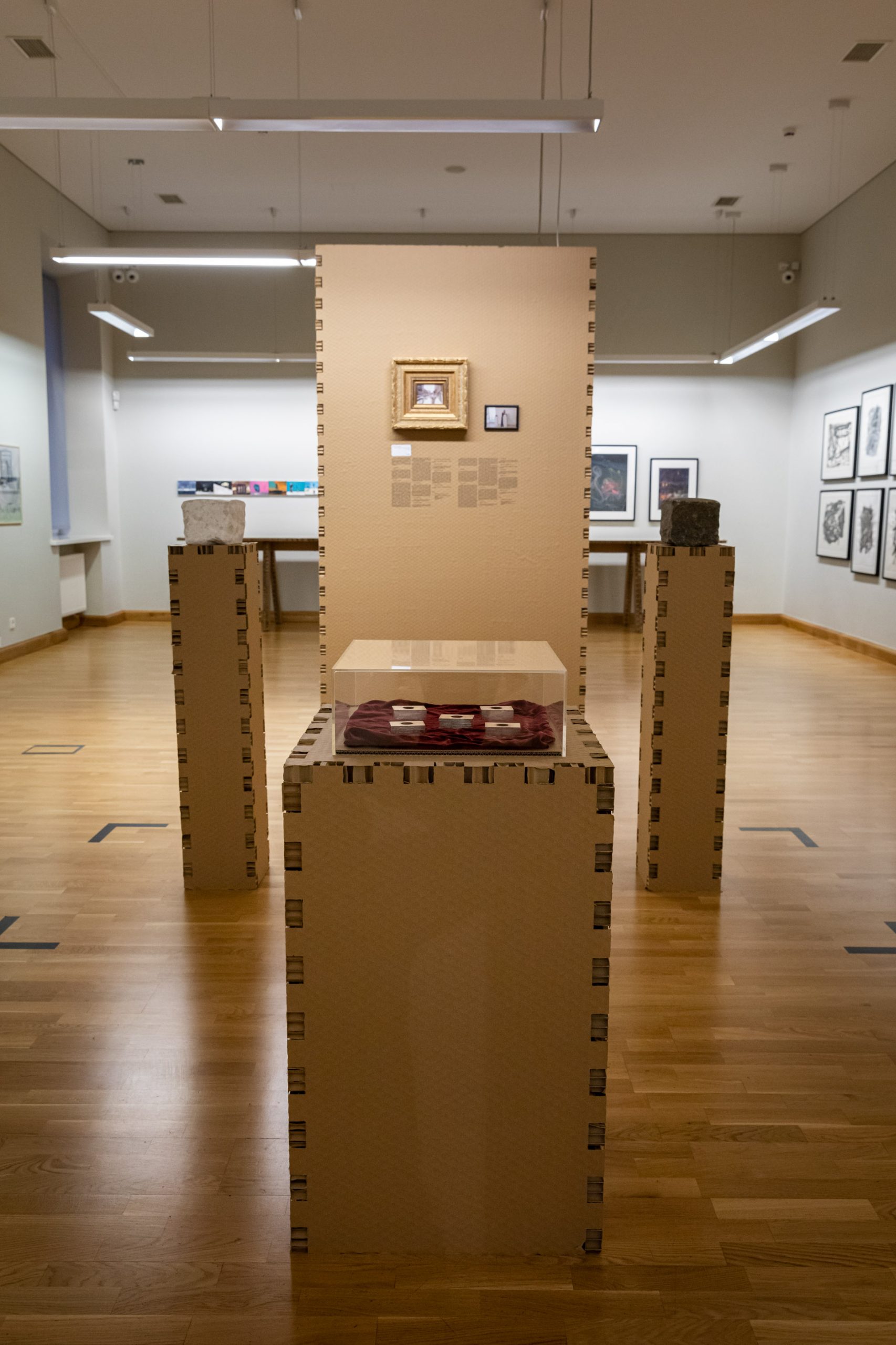
During one of the Venice biennials, I mined a cobblestone from the road. I brought it to Lithuania and made a marble copy of it. Then I arranged it with a priest to bless that copy for me. Afterwards, I chipped off a corner of the copy, gilded that piece, and placed several fragments of it into reliquaries. In Paris, I met a curator from the museum of mediaeval art and after discussion with her, I decided on the type of reliquaries I am going to use.
The lost words
I am in Paris, and I have lots of time. Each day, I pay a visit to one of the museums. Every third day instead of doing museums, I just roam the streets. The rest of the time can be dedicated to writing. I want to write so much that afterwards I can do no writing for a long time. I come up with a plan of action: while in Paris, I am going to write so much that upon returning to Lithuania I can quit my job and dedicate all my time to finishing the artworks that I could not complete due to different hurdles. Such is my super plan. I jubilate over such opportunities and cannot wait until I actually get down to work.
Day one in Paris
I sit down at the table and look around. All looks great: the light drizzle on the street, the quietly burbling wall-radiator, and the black floor tiles predispose for work. I open my computer and get ready to write. A man on the phone asks whether he may collect a second set of bedding (which I do not need). I tell him he may. In about 15 minutes, the errand with the bedding is over and I can again compose myself for writing. I am going to write about footprints. I have thought it over, so I only need to type it down. I write my first word. I read it and cannot understand what it says. In my head, I try to put the letters together, but they fail to make any sense. I read them aloud. I get a strange combination of sounds that I never heard before. ‘Never mind’, I say. Things do happen. I simply have to go on writing, and the word will come back later. My keyboard is set to the Lithuanian language, and the word is not underlined in red, hence, it is spelled correctly and I can move on. I type my second word. I look at two incomprehensible collections of letters. The first is shorter, and the second longer. It is not underlined either, so it will work out, I only need to continue writing. Yet my third collection of words is underlined, and so is next and the fifth. I look at them unable to figure out the nature of the problem. I delete all my writing and start again. Now even the first one is underlined. I look at the letters attempting to compose a word. I know what word it should be, but I cannot put it together from the letters I have typed. When this happens, it makes no sense go on writing. Words will come back later; meanwhile I can do something else. I go out for a walk.
I come back at dusk. I sit down to writing. I type a couple of words and understand what they mean. My words are back. Reassured, I keep writing without looking at the screen. When I look up, I see that everything except the two initial words is underlined in red. I try to read my writing. Words are gone again. I delete these combinations of letters. I try again. And again. There are more and more underlined, unintelligible sequences of letters. I delete it all and close my laptop. I take a sheet of paper and start writing. Maybe writing in pen will be more effective. My ballpoint pen glides neatly across a sheet of paper leaving some kind of scribbles. Now even letters are no longer recognizable. It is bad indeed. This has never happened to me before. I start wondering if I can read yet. I find an old issue of the Kultūros barai magazine left behind by somebody, open a random page and start reading. With some effort, I can connect letters into words. I read one article, then one more and yet another. The more I read, the easier it becomes. Finally, I can read without any effort. I sit to writing again. Words disappear again. I go to bed. Tomorrow I will do better.
Day two in Paris
Words have not returned yet. When I try reading – all is fine. When I try writing, I fail. I try to copy several words from the magazine. While I write, the meaning disappears. After that, I cannot read them in the magazine. The risk is too high so I stop the experiment. I keep reading. All seems OK. I take my recorder and dictate what I intended to write. I listen to the recorded text. I don’t like it all. I dictate it again and again. But there are too many mistakes and I do not think it makes sense to keep dictating the text as long as I cannot put it down and correct. I need to regain my words. I delete the recorded text and go out.
Day three in Paris
Words are not back. I can only read very simple texts. (The words in Kultūros barai are also gone).
Day four in Paris
I try writing in Lithuanian, English and Russian. Words keep disappearing. I cannot write. I cannot read Lithuanian texts.
Day five, six, seven, eight in Paris
I pay a visit to friend in Grenoble. I do not try writing or reading.
Day nine in Paris
While I was visiting Grenoble and climbing the Alps, words have not returned. I still cannot read Lithuanian or complex English texts.
Someday in Paris
I decide that I simply must write something. I switch off the spell checker; I stare for a while at the blinking cursor on the screen. Finally, I start writing. I pour out everything I have been willing to write. It goes on like sail. My fingers hardly manage to keep up with my thought. I
have never been writing so fast. If I do not lose the wind, I will catch up with the lost time easily. I look up and try to read my text. I can understand nothing. Maybe I just cannot read it. Maybe it is all correct. I switch on my spell checker. Everything goes red. Not a single underlined word remained. I delete it all. I look again at the blinking cursor on the empty page.
My last day in Paris
I clean up the studio. In nearly a month, I have not written a single word.
Viktoras Liutkus
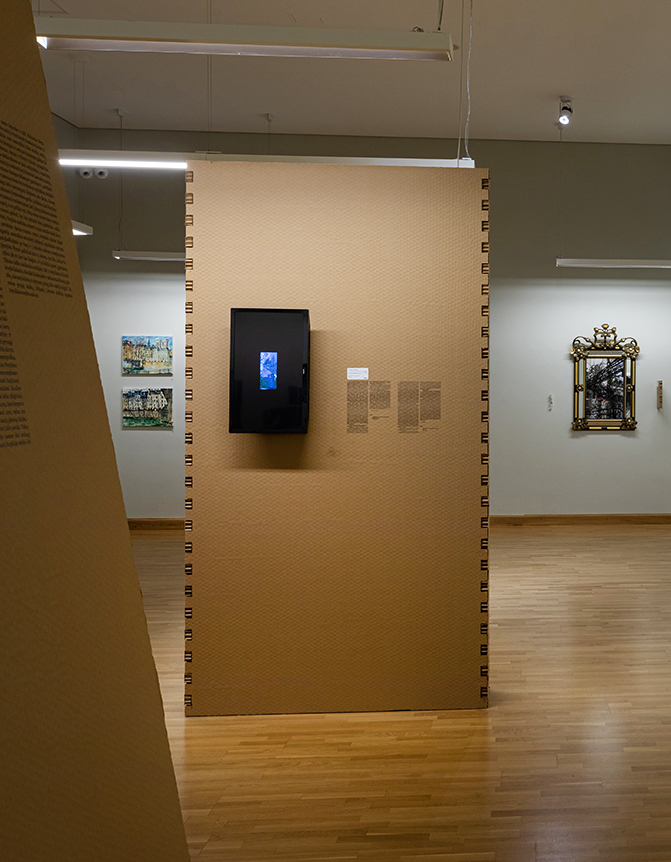
The answer will be given in heaven
I arrived to the Cité Internationale des Arts in April 2019, with serious intents. First, I was interested to see the studio that caused a lot of headache back in 1994 when we wanted to acquire it for the use of Lithuanian artists. At the time, I worked for the Arts Department of the Ministry of Culture of Lithuania, and we received a pleasant letter from Paris inviting us to become part of the international artists residence, e.g., to rent a studio for the Lithuanian artists. We had no doubts – it was necessary! Yet we could in no way get the then minister of culture interested in the studio. Economic difficulties, aftereffects of the blockade and legal restrictions dampened his enthusiasm. The lines of the approved state budget prevented the ministry from committing funds to unexpected needs. They never said either yes or no, and the matter waited in limbo. Days and weeks passed, and we gave no answer to the French. Luckily, Arvydas Šaltenis stepped on the scene, becoming rector of the Academy. He did not hesitate, but found a way to arrange it with the Seimas to alter the budgeting line for the Academy, and to pay the required contribution… The Cité Internationale des Arts opened its doors to the Lithuanian artists.
I arrived in Paris with a detailed list of museums, exhibitions, streets, market places, cemeteries, libraries, squares, bookshops, monuments and other places I intended to visit, to take pictures and to make notes. A month, unfortunately, was not enough. I was happy that following my visual guide I managed to locate the places where during his trip to France in 1937 the avant-garde painter Vytautas Kairiūkštis drew bridges across the Seine, the beginning of the storied Rue Lepic in Montmartre and the buildings of the city. I found the vantage point by the Pont Saint-Michel where the artist stood to sketch a panoramic view of the Seine, the Pont-Neuf with the roofs of the Louvre jutted in the distance. I also traced the point on the Quai des Orfèvres from where in his travel book, the painter drew the southern tower of the Palais de Justice. He redrew the same motif in pastels. Thus, he was walking around and drawing within a short distance from the Cité Internationale des Arts. He walked also as far as Montmartre, and drew in pastels a motif of the Rue Lepic with a parked car. Kairiūkštis plans included more than Paris where he spent two weeks with its museums and exhibitions, but also other places in France of his five-week trip.
My impressions of my April in Paris are reflected in my daily notes. These are extracts of two of diary entries:
Saturday, April 13
/…/ I sit in the central nave (of the Notre Dame Cathedral) waiting for a concert to start and look at the stained glass, wondering where is the source of light falling on the ornaments of the vaults? I keep a branch of greenery, my Easter palm in my hand, a symbol to take home as well as a donation to the cathedral. Before the concert starts, I ask my wife, what if the vaults collapsed, what would remain? Just think of the height! Stop it, she says. The organ sounds great. After the concert emerges the organist in a red pullover /…/
Monday, April 15
/…/ from the early morning I am again working at the Centre Pompidou and spend in it three good hours /…/ I was at the Centre in 1992, when I came to collect the sculpture pieces by Antanas Mončys gifted to Lithuania. I do not know what remained in the collections, and the paintings I had seen faded from my memory, only the squeaking sound of the elevators remained the same /…/
/…/ yet the entire drama of Paris, the drama of Europe broke out in the evening when I was already back from the Centre Pompidou. ‘Why are these helicopters circling around?’ my wife asks. Well what do we know, but I look out of the window and see smoke. I figure out something going with the Notre Dame. I turn on my computer – jeeeeez! I dash out and what I see is more shocking than any movie. Open flames dancing on the roof of the Cathedral, the spire already gone, thick white, brown and grey smoke rises in billows. People have crowded on the Pont Marie, on the Pont Louis-Philippe, and filled up the streets. Sirens roar, motorcycles, fire engines, police cars dash by. The crowd stands waiting for something, but in their waiting, they are living through an internal drama. For everyone, confronted with such a sight, it opens a floodgate of thoughts and images about European civilization, Christianity, art, literature and personal experiences. It is heart breaking… I ask myself, why the Lord punishes his best home. In several hours, the archbishop of Paris askes the same question on TV and answers it to himself ‘I do not know. Perhaps I’ll find out only in heaven’.
June 2020
Vidas Poškus
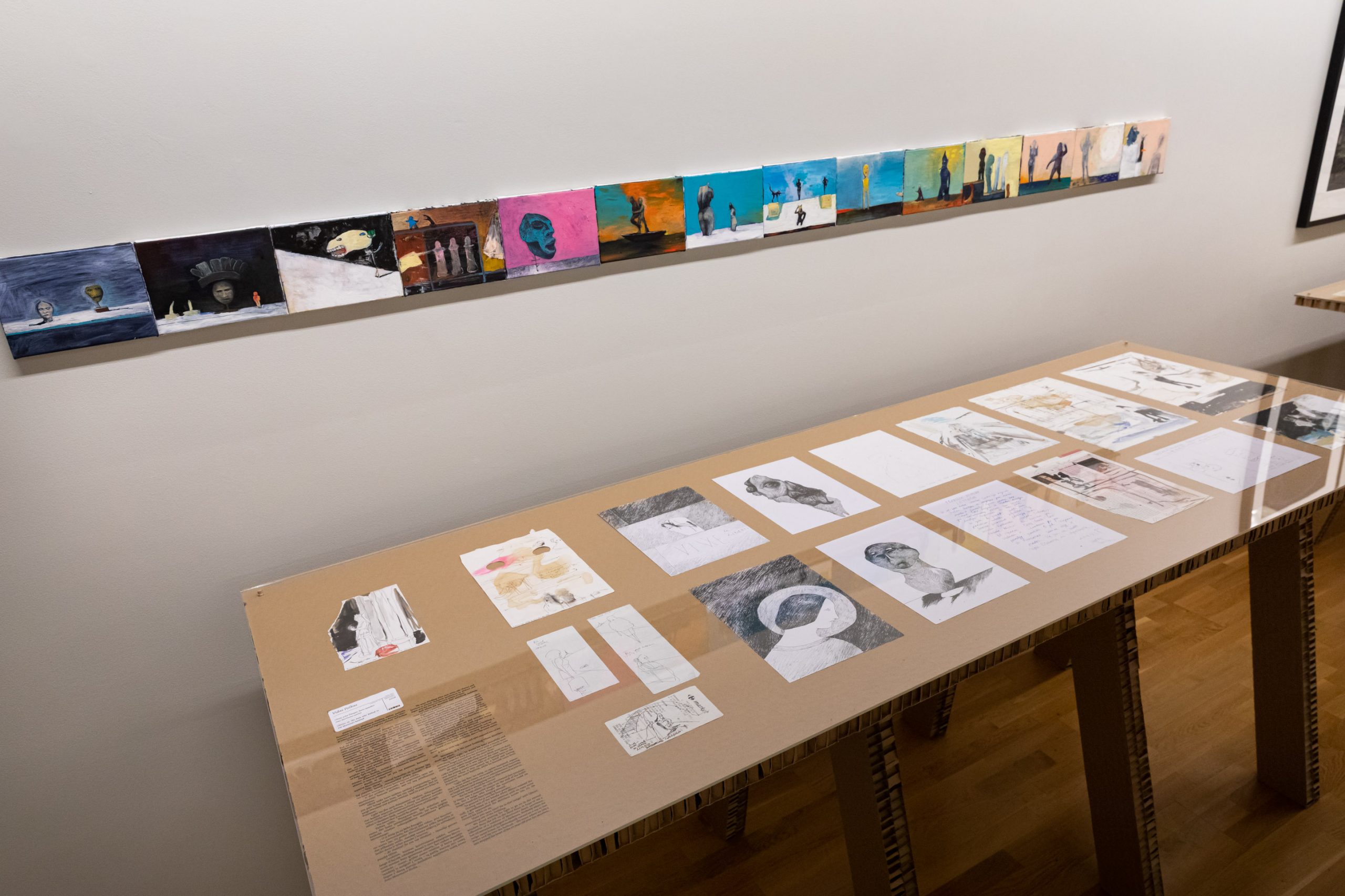
Olivier; or, The man who bathed in Jim Morrison’s bathtub
We were drinking wine over some idle chatter and listened to French chansons (performed by Maksas and Sigis) and the Doors in the very centre of Paris.
‘And where did Morrison die?’ somebody suddenly came up with a question.
Right away, we found out (the omnipotent Internet!) that it happened almost there – within a stone’s throw from our place. We grabbed what was left from the cheap red wine (about half a bottle), three glasses and scrambled into a summer megacity drowned in an unrestful sleep.
We asked all the passers-by met on the way – a bicyclist who stopped for the sake of Morrison and his death and even checked the address on his smart phone, an amiable elderly gentleman who gave us directions gesturing to go ‘direct, left and left again’.
Then we discovered what we had scribbled with shaking and disobedient hands on a cash register receipt (that excitement): 17-19 RUE BEUATREILLIS…
An empty, tranquil street. A five-storey building, a café in front (with a deep interior commotion) and us.
‘Come on baby, light my fire,’ we sang. Nobody could recall more of the lyrics, probably, due to the same excitement.
A fellow with big, rather sad eyes stepped out of the café.
‘Monsieur, is it the same building where Morrison died?’ we asked.
‘Yes, that’s right,’ he waved his head peacefully and stretching out his long pianist’s hand with a nearly manzaresque finger pointed to the window, ‘that window over there, second from the left on the third floor.’
He also asked (imploring) not to drink wine on their café’s marble table as it was against the rules. Olivier (it was the young man’s name) told us of having been to the apartment when it was owned by a hotel and having bathed in the same bathtub, while he himself came from Provence.
‘Light my fire,’ we sang, or rather hummed, repeating it some seven times, meanwhile Olivier kept entering the café (where he worked as an administrator, bartender or head waiter) and stepping out as if he wanted to join in, ‘you know that it would be untrue!’
Yet he kept silent. He only mentioned that previously there was a memorial plaque on the wall of the building, but a judge who bought the apartment could no longer stand the fans hanging around.
‘In general he is not the best person.’
During one of the breaks when Olivier entered the café, a gentleman in a grey raincoat with an even more grey face approached the Morrison house (No 17). He turned his back on us,
‘Have you seen him? He is that judge!’ said Olivier, scrambling out of the building.
We stood waiting for light to go on in the second window from the left on the third floor, in hope to see a silhouette of a resident of Morrison’s death apartment, but all remained plunged in darkness. Probably when the judge came home, he immediately turned on a tap to run water and lay into the bathtub – the same where on July 3 1971 stopped the heart of the 27-year-old poet Jim Morrison…
Vilma Šileikienė
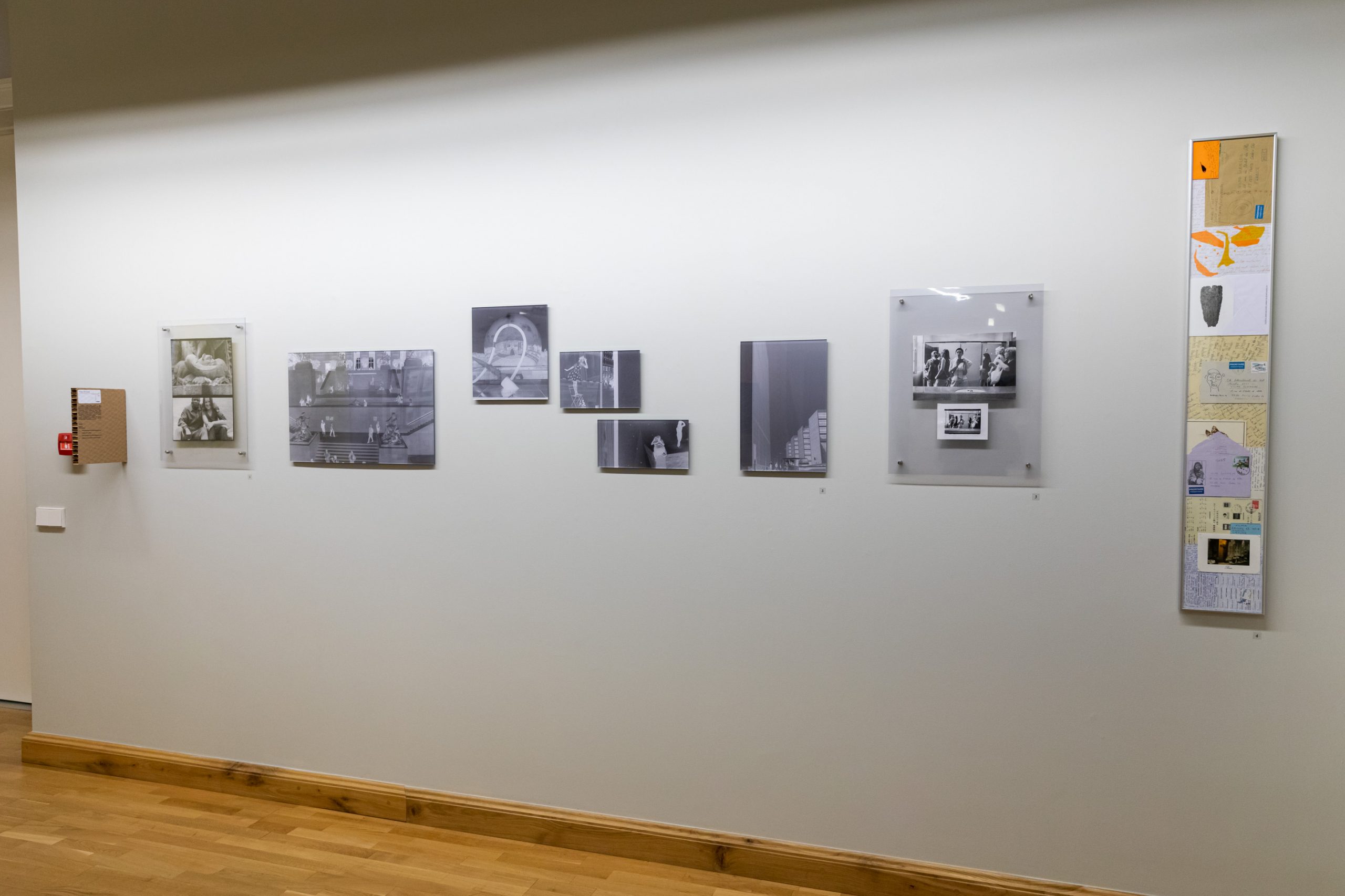
My imagination nestled the image of Paris similar to the photographs of Henri Cartier-Bresson. I found this (imagined) atmosphere of Paris in a touristy postcard, bought it and posted to myself as a memento. Every day, I was out to collect images with the camera shutter. Every time I hoped to have caught something super-exciting, yet again it was… not that. Paris played hide and seek with me. Module P is just one of many possible versions of the story. My search for the former Paris – the artefact of the present-day Paris.
To borrow a phrase from Jeroslavas Melnikas, ‘Paris is a different mind-set, a different logic in every aspect.’ (Jeroslavas Melnikas Paryžiaus dienoraštis, Alma litera publishers, 2013, p. 19)
Vladimir Tarasov
Paris is a city of immense cultural history and is like a guiding light to all the countries and surely, to me personally. The studio of Cité Internationale des Arts provides an opportunity to stay in solitude and concentrate on productive work. You feel stimulated by another circumstance (though to some this may strike as strange) – the opportunity to step out and experience the pleasure of visiting exhibitions and concerts that are on in the city. It is a priceless chance to see art in the original, not in reproductions, which is so inspiring and invigorating, when you come back and continue your creative work.
1 Goštauto st, Vilnius, Lithuania
+370 5 261 6764.
kasiulio.muziejus@lndm.lt













